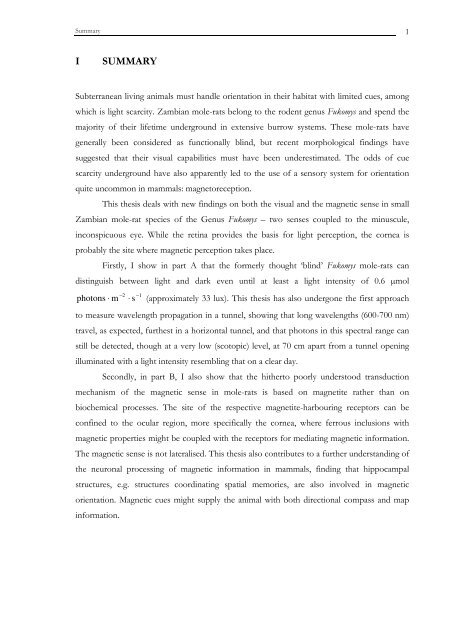Antigen Biotinylated Anti-Rabbit lgs Rabbit Primary Antiserum AB ...
Antigen Biotinylated Anti-Rabbit lgs Rabbit Primary Antiserum AB ...
Antigen Biotinylated Anti-Rabbit lgs Rabbit Primary Antiserum AB ...
Create successful ePaper yourself
Turn your PDF publications into a flip-book with our unique Google optimized e-Paper software.
Summary<br />
I SUMMARY<br />
Subterranean living animals must handle orientation in their habitat with limited cues, among<br />
which is light scarcity. Zambian mole-rats belong to the rodent genus Fukomys and spend the<br />
majority of their lifetime underground in extensive burrow systems. These mole-rats have<br />
generally been considered as functionally blind, but recent morphological findings have<br />
suggested that their visual capabilities must have been underestimated. The odds of cue<br />
scarcity underground have also apparently led to the use of a sensory system for orientation<br />
quite uncommon in mammals: magnetoreception.<br />
This thesis deals with new findings on both the visual and the magnetic sense in small<br />
Zambian mole-rat species of the Genus Fukomys – two senses coupled to the minuscule,<br />
inconspicuous eye. While the retina provides the basis for light perception, the cornea is<br />
probably the site where magnetic perception takes place.<br />
Firstly, I show in part A that the formerly thought ‘blind’ Fukomys mole-rats can<br />
distinguish between light and dark even until at least a light intensity of 0.6 µmol<br />
photons<br />
−2 −1<br />
⋅ m ⋅ s (approximately 33 lux). This thesis has also undergone the first approach<br />
to measure wavelength propagation in a tunnel, showing that long wavelengths (600-700 nm)<br />
travel, as expected, furthest in a horizontal tunnel, and that photons in this spectral range can<br />
still be detected, though at a very low (scotopic) level, at 70 cm apart from a tunnel opening<br />
illuminated with a light intensity resembling that on a clear day.<br />
Secondly, in part B, I also show that the hitherto poorly understood transduction<br />
mechanism of the magnetic sense in mole-rats is based on magnetite rather than on<br />
biochemical processes. The site of the respective magnetite-harbouring receptors can be<br />
confined to the ocular region, more specifically the cornea, where ferrous inclusions with<br />
magnetic properties might be coupled with the receptors for mediating magnetic information.<br />
The magnetic sense is not lateralised. This thesis also contributes to a further understanding of<br />
the neuronal processing of magnetic information in mammals, finding that hippocampal<br />
structures, e.g. structures coordinating spatial memories, are also involved in magnetic<br />
orientation. Magnetic cues might supply the animal with both directional compass and map<br />
information.<br />
1

















